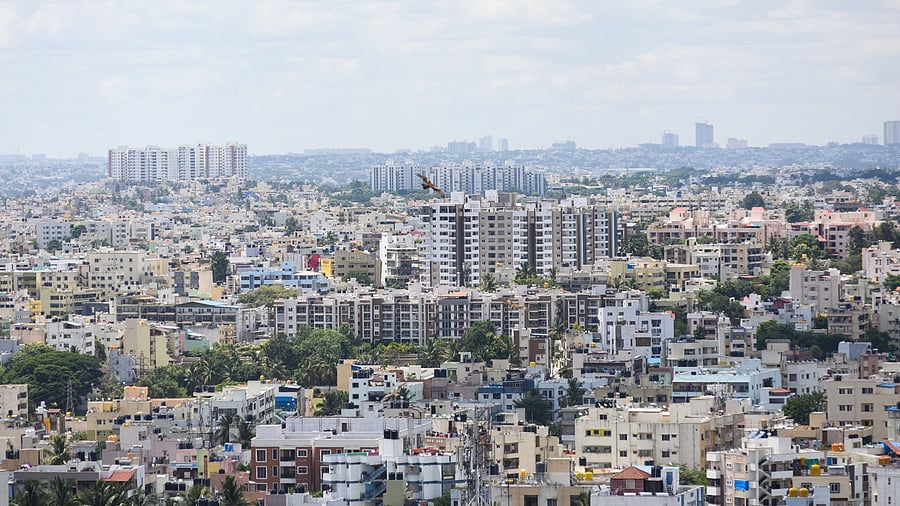
The project could take over 8-10 years to complete as it is the first urban tunnel project passing through a dense residential locality.
Credit: DH File Photo
Bengaluru: In a span of three months, the BBMP has drafted a detailed project report (DPR) for a six-lane tunnel road, covering a stretch of about 16.68 km between Central Silk Board and Hebbal. The twin-tube, unidirectional road will have three intermediate locations connected by ramps for vehicle entry and exit. The project, estimated to cost Rs 14,981 crore, aims to reduce travel time by 20 minutes, compared to the current travel time of about one and a half hours.
According to the detailed project report (DPR), the underground road is expected to be completed in five years. However, in reality, construction work could extend beyond 8 to 10 years, as it will be the first urban tunnel project in the city, passing below residential areas. What’s more, the tunnel will be located about 100 feet below the surface, which is twice as deep as the Namma Metro’s underground network.
In total, there will be as many as 16 entry and exit ramps to the tunnel, with lengths ranging from as short as 360 meters to a maximum of 1.9 km. The total length of these ramps is significant—longer than the actual tunnel itself. This includes three intermediate ramps at locations such as Mekhri Circle, Race Course Road, and Lalbagh.
The BBMP plans to implement the project under a Build-Operate-Transfer (BOT) model, where a private firm will receive toll rights and other benefits for funding 70% of the project cost. The remaining costs will be covered by the state government through viability gap funding. For now, the civic body has set the toll fee at Rs 16 per kilometre, which would amount to approximately Rs 267 for travelling the entire road.
‘Shoddy planning’
Activists argue that the project is on weak footing, both legally and technically. They have also questioned its necessity, given that the government has already proposed a Metro line along the same stretch.
Transport planners have gone further, labelling the 16.68 km tunnel road as an example of “lazy planning” that will not solve the city’s traffic problems.
“The project will take at least ten years to complete. By that time, traffic on all roads will be jammed anyway. What difference will it make to travel faster on only one road, and that too for a short stretch?” wondered one traffic planner, who requested anonymity.
He argued that the project might benefit a small segment of the population, but the majority will continue to suffer. “The government should instead create a master plan that looks at transportation solutions for the entire city comprehensively. Decongesting Bengaluru is the only real solution. It can be done by creating facilities in neighbouring cities where people can live, work, and play. Tunnel roads or elevated roads are not just myopic ideas, but lazy planning that will drive the city into decline,” he cautioned.
The underground road — proposed rather suddenly — will interfere with both Metro and suburban rail projects at multiple points. According to the DPR, Namma Metro will need to expand its viaduct at three locations to relocate its pillars. In three more places, the tunnel will pass below the underground Metro corridor. In two areas, the tunnel ramps will run parallel to the Metro line. The road project will also obstruct suburban rail alignment at two points.
DPR silent on tree loss
In the DPR, the BBMP has stated that the tunnel road does not require a detailed environmental impact assessment (EIA) as the project does not fall under either Category A or B as defined in the Ministry of Environment, Forest, and Climate Change (MoEFCC) notification. The DPR is, however, silent on the extent of tree loss, damages to the aquifer, the number of live borewells along the stretch and the land required for the project.
Rajkumar Dugar, convener of Citizens for Citizens, raised concerns over technical flaws in the DPR, particularly regarding traffic data for Nashik and Malegaon, as well as the significantly longer lengths of the ramps. Based on the entry and exit provisions, he believes the tunnel mainly caters to airport commuters, as well as those travelling to Vidhana Soudha, Electronic City, and Outer Ring Road.
“A very large part of the city, even along the tunnel’s alignment, will find it difficult to make use of the tunnel,” he said.
Moreover, the BBMP has yet to hold a public consultation for the project, a legal obligation under the Karnataka Town and Country Planning Act.
Vijayan Menon, president of Citizens’ Action Forum (CAF), criticised the Congress-led government for “murdering the constitution and democracy” by rushing through the tunnel project without following proper legal procedures.
“Regardless of whether the tunnel is beneficial or not, it should not have been proposed without consulting the Metropolitan Planning Committee (MPC), BBMP councillors, and the public at large. This is a constitutional
requirement.”